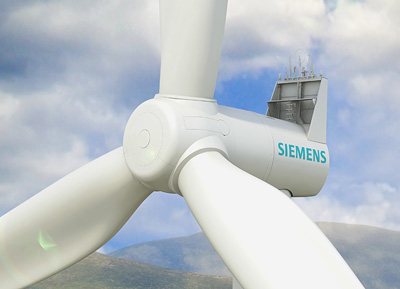Siemens to supply 12 direct-drive wind turbines to Süderlügum in Schleswig-Holstein

Option "Reactive Power at No Wind" helps for grid stabilization.
Siemens Energy has secured an order for a total capacity of 36 megawatts (MW) in Nordfriesland. Siemens is to supply twelve direct-drive wind turbines, eleven model SWT-3.0-113 and one model SWT-3.0-101 turbine, for the Süderlügum publicly-operated wind farm. The installation of Süderlügum onshore wind power plant is scheduled for late 2014. The owner has contracted Siemens for service and maintenance for a period of 20 years to ensure the long-term economical operation of the wind farm.
This onshore order from the coastal region of Nordfriesland is the third project with Siemens to be implemented by Reinhard Christiansen, who manages the publicly-operated wind farm business together with Horst Leithoff and Peter Steffens. Prior to this the partners were involved in erection of the Grenzstrom Vindvedt and Ellhöft publicly-operated wind farms. Thanks to some special equipment the Süderlügun wind farm will not only be producing electricity when the wind is strong. Even when no wind is blowing, the wind farm helps stabilize the power grid by feeding in reactive power. This provides additional economic benefits for the owner/operator.
The Süderlügum wind farm is located around 20 kilometers from the North Sea coast. Each of the 12 wind turbines has a capacity of 3 MW. Compared to conventional, geared units, these turbines have half as many parts and considerably less moving components. This enhances efficiency and reduces operating costs.
Reinhard Christiansen explains: “Süderlügum is an important project for the local population that will make a collective contribution to the energy turnaround. As with our other two wind farms, Süderlügum will also supply clean electricity that is funded entirely by the public.” Construction of the wind farm also represents a significant infrastructure project for the Nordfriesland region.
Süderlügum even takes advantage of renewable energy sources during calm weather. This is made possible by the “Reactive Power at No Wind” technology from Siemens. This option enables the wind turbines to stabilize the alternating current power grid when no wind is blowing, by producing reactive power and feeding this power into the grid. This reduces operating costs for the regional power supply grid while doing away with the need for phase shifters. Reactive power compensation will also provide remuneration to the wind farm operator/owner, for this feature is used by the plant to resolve a technical problem related to distributed power generation: When industrial customers take large volumes of active power from the grids, grid frequency faults frequently occur which cause heating of the lines in the grid. The “Reactive Power at No Wind” option enables the Süderlügum wind farm to actually counteract this frequency displacement.
Wind power and energy service are part of Siemens' Environmental Portfolio. Around 43 percent of its total revenue stems from green products and solutions. That makes Siemens one of the world's leading providers of eco-friendly technology.
The Siemens Energy Sector is the world's leading supplier of a broad spectrum of products, services and solutions for power generation in thermal power plants and using renewables, power transmission in grids and for the extraction, processing and transport of oil and gas. In fiscal 2013 (ended September 30), the Energy Sector had revenues of EUR26.6 billion and received new orders totaling approximately EUR28.8 billion and posted a profit of approximately EUR2 billion. On September 30, 2013, the Energy Sector had a work force of approximately 83,500. Further information is available at: http://www.siemens.com/energy
Reference Number: EWP201407057e
Contact
Mr. Bernd Eilitz
Energy Sector
Siemens AG
Lindenplatz 2
20099 Hamburg
Germany
Tel: +49 (40) 2889-8842
All latest news from the category: Corporate News
Newest articles

Parallel Paths: Understanding Malaria Resistance in Chimpanzees and Humans
The closest relatives of humans adapt genetically to habitats and infections Survival of the Fittest: Genetic Adaptations Uncovered in Chimpanzees Görlitz, 10.01.2025. Chimpanzees have genetic adaptations that help them survive…

You are What You Eat—Stanford Study Links Fiber to Anti-Cancer Gene Modulation
The Fiber Gap: A Growing Concern in American Diets Fiber is well known to be an important part of a healthy diet, yet less than 10% of Americans eat the minimum recommended…

Trust Your Gut—RNA-Protein Discovery for Better Immunity
HIRI researchers uncover control mechanisms of polysaccharide utilization in Bacteroides thetaiotaomicron. Researchers at the Helmholtz Institute for RNA-based Infection Research (HIRI) and the Julius-Maximilians-Universität (JMU) in Würzburg have identified a…



